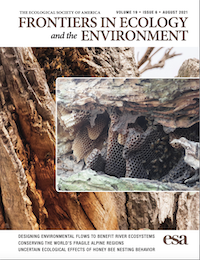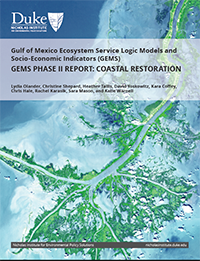Beplay全站app
Global Climate Change and Human Health: From Science to Practice, 2nd Edition
This chapter from Global Climate Change and Human Health: From Science to Practice discusses how various ecosystem services affect human health and describes how climate change might disrupt or alter the delivery of those services.
Connecting Ecosystem Services Science and Policy in the Field
The authors outline the framework used to teach environmental policy instruments through the “Five P’s”: prescription, property, penalty, payment, and persuasion and then discuss the discrete ecosystem services research required to effectively implement each tool.
寶石第二階段報告:沿海飯館ration
This Phase II report of the GEMS project identifies metrics available to monitor the social and economic outcomes of a wide variety of coastal projects funded in the Gulf, using ESLMs to illustrate how these projects’ impacts cascade through the biophysical system to result in social and economic outcomes. Phase II expands the focus to assess socioeconomic metrics for 16 coastal project types, including habitat restoration, recreational enhancement, and water quality improvement projects.
Exploring the Use of Ecosystem Services Conceptual Models to Account for the Benefits of Public Lands: An Example from National Forest Planning in the United States
一個共同的理解的好處和tradeoffs to people from alternative land management strategies is critical to successful decision-making for managing public lands and fostering shared stewardship. This study describes an approach for identifying and monitoring the types of resource benefits and tradeoffs considered in National Forest planning in the United States under the 2012 Planning Rule and demonstrates the use of tools for conceptualizing the production of ecosystem services and benefits from alternative land management strategies.
Streams of Revenue: The Restoration Economy and the Ecosystems It Creates
An analysis of stream mitigation banking and the challenges of implementing market-based approaches to environmental conservation.
Recognize Fish as Food in Policy Discourse and Development Funding
The international development community is off-track from meeting targets for alleviating global malnutrition. Meanwhile, there is growing consensus across scientific disciplines that fish plays a crucial role in food and nutrition security. However, this ‘fish as food’ perspective has yet to translate into policy and development funding priorities.
A Practice-Oriented Approach to Foster Private Landowner Participation in Ecosystem Service Conservation and Restoration at a Landscape Scale
Large landscape conservation planning often requires managers to coordinate with private landowners, especially in regions like the southern and western U.S. where private landownership dominates. It is often difficult to design conservation programs that incorporate varying landowner perceptions, values, and ownership objectives. Simple and transferable methods are needed to inform the design of landscape-scale conservation and restoration programs, and we propose that this can be done by targeting ecosystem services (ES) of interest to private landowners.
Mapping Ecosystem Services for the Southeast United States: Conservation and Restoration Priorities for Water Purification
This methods brief focuses on water purification by natural land cover, which removes nonpoint-source pollutants from runoff water before they reach waterways. This analysis maps natural land cover within the likely flowpaths of water from agricultural areas to waterways.
Testing Ecosystem Accounting in the United States: A Case Study for the Southeast
Ecosystem accounts, as formalized by the System of Environmental-Economic Accounting Experimental Ecosystem Accounts (SEEA EEA), have been compiled in a number of countries, yet there have been few attempts to develop them for the U.S. We explore the potential for U.S. ecosystem accounting by compiling ecosystem extent, condition, and ecosystem services supply and use accounts for a 10-state region in the Southeast. The pilot accounts address air quality, water quality, biodiversity, carbon storage, recreation, and pollination for selected years from 2001 to 2015.
USFS Predictive Model Library: Fire and Timber Management
This project explores how these non-USFS models could be combined with existing USFS models to provide a fuller analysis of ecosystem services outcomes from different management scenarios. We used an ecosystem service conceptual model as a framework to examine the utility of currently available predictive models for quantifying the effects of fire and timber management on ecosystem services and socioeconomic outcomes.










